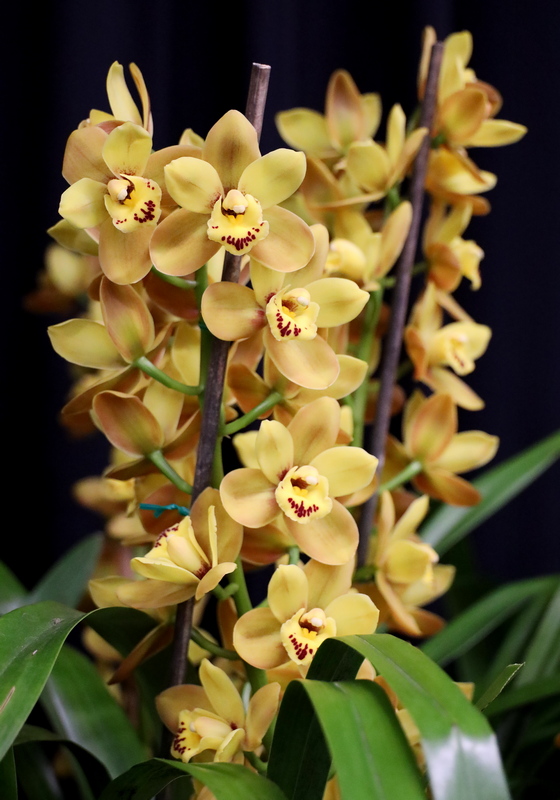It’s never too soon to start thinking about how your plants can look their best for our show on September 23 and 24. Some of the tips suggested here will have to be done at the last minute though.
Protect: If you have an orchid growing outside that you think may be in flower for the show, make sure the plant is under cover as the buds develop to protect it from weather damage. Check the pot and plant carefully for any hungry pests that may also damage the flowers. When watering, be sure to water into the pot and try to avoid splashing the leaves and developing flowers.

Stake: Stake any blooms that need it – people like to look into a flower rather than at its drooping back. This is a job that should be done as soon as possible when the flower spike appears. However, if you’re careful it can be done later. Remember, though, that clipping or tying a strong-stemmed plant, such as a Cymbidium, to a stake is best done in the middle of a warm day when the stem is more flexible and less likely to snap! Choose the most unobtrusive stake and clip colour possible, and trim the stake with secateurs (or similar) to the height of the flower spike, again to keep it unobtrusive. Even if you don’t wish to display a staked bloom, you may want to consider staking a spike to support it as you transport the plant to the show.
Trim & Tidy: Trim any damaged leaves to a natural leaf shape and remove any spent canes from hard-cane Dendrobiums (not from Dendrobium nobile types as these flower on leafless canes). Remember to sterilise your cutting tool between cuts, and without fail between plants. Trim or pull out any dead papery sheath material, last year’s flower spikes, and any weeds in the pot. Check the health of back-bulbs by giving them a gentle squeeze. If they’re hollow or pulpy, carefully remove them unless it’s too difficult.
Label: Insert a clearly written plant-name label at the front of the pot. It will stop visitors fiddling with your plant to try and see the name. We do have signs asking people not to touch the display and floorwalkers keeping their eyes open, but …
Water: Give your display plants a good drink and feed one or two days before they come to the show, not that morning as the pot and bark will still be wet as it goes on to the display. Soaking the whole pot in a bucket for an hour will ensure the plant gets a good drink and be able to ‘go without’ for 2-3 days. They cannot be watered once they are on display.
Clean: The day before your plants come to the show wipe the foliage with a damp cloth to remove dust and debris, and/or dip the cloth in a little watered-down milk to add shine to the leaves. You may have to wipe leaves more than once to get them looking good. It’s not a difficult task, just a bit time consuming so have the radio on while you wipe.
Wiping the leaves is a good chance to check your plants for pests. No one wants to be ‘the one’ whose plant comes into the hall with snails, slugs, mealybug, scale, ants, etc and ‘infects’ neighbouring plants. If your plant is badly infected with something, please leave it at home.

Pot: Plants should preferably be in a clean, black pot. If this isn’t the case, do you have a clean, black pot (plastic or ceramic) slightly larger than the plant’s pot? Pop the whole thing into the black pot and Bob’s your uncle. Why do we prefer a black pot? Because we display the plants on black cloths. A black pot means the viewer’s eye is captured by the flowers and not a competing colour further down.
Bark: If the bark is looking old or there’s moss on top of the pot, scrape off the top layer of bark and replace it with fresh bark, or wind some Spanish moss around the top of the pot as a disguise. Soak the Spanish moss the day before you come and it will help keep the orchid roots moist during the show.

Mounted: If your plant grows on a mount, please consider how this might be best displayed. Do you have a stand for it that you can bring that will show it off? The club may be able to help, so please ask ahead of time.
Name: Put your name on the back of the pot. We don’t want to be responsible for lost or forgotten plants so please make sure your pots are named. If you’re bringing several plants to show – and we hope you are – it helps to write a list of the plants so you can check them off when you collect them.
Outsize: If you have a super-big plant to bring, it might be an idea to let the show organisers know beforehand. The layout of the display is being kept simple this year so it might be helpful to know if any allowances need to be made for particular plants.
